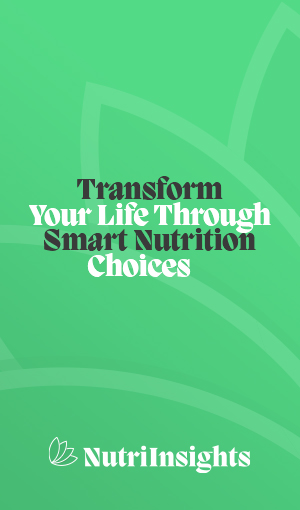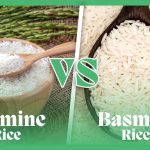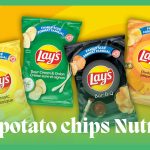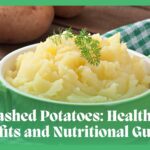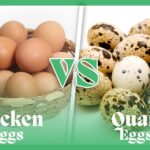In recent years, there has been quite a buzz around an often overlooked hero that offers a unique flavor and wide array of health benefits—Plantain. This tropical symphony is not just a culinary delight, but a haven for vitamins and minerals that deliver unique advantages.
Today we enter the intriguing world of plantains and reveal the nutritional mysteries hidden underneath its thick skin. From the market to the dining table, these velvet bananas have the potential to revolutionize the way nutrition is perceived. This discovery is not just to understand its nutrients but rather the fact that incorporating plantains into our everyday diet can have huge effects on our well-being. From its role in digestion to its benefits in maintaining strong bones, this unassuming fruit does it all on its own.
Come along as we provide the center stage to this vegetable-like fruit and showcase its remarkable nutritional qualities!
What is Plantain?
Plantain bananas- a part of the banana family are a staple in many tropical regions. Due to their high starch content in raw form, they are cooked and eaten green, while the ripe plantain has a mild sweet taste. They are usually consumed as fried, baked, and boiled while in Caribbean and West Indian cooking, the green plantains are dried and ground into flour powder.
The plant of plantain is enormous usually 3-10 meters large that emerges from the underground stem. The fruit is larger and thicker than the typical banana and comes in green, yellow, or brown-yellow. Yellow plantains are sweeter and softer than their green counterparts.
The plantain plant is thought to have emerged in Southeast Asia with India, Africa, Egypt, and tropical America being the major producers. They are a staple in many traditional dishes in regions of North and Latin America, Africa, the Caribbean, and Southeast Asia.
An interesting fact regarding cooked plantains is that nutritionally they are very similar to potatoes but are more abundant in certain vitamins and minerals like vitamins A, C, B6, and potassium.

Know your plantains:
Plantains have three major ripening points which may help you pick up the right ones depending on your choice:
Green plantains:
Green or unripe plantains have a hard pulp and require a knife to remove the peel. Similar to potatoes, they are starchy, less sweet, and perfect for making plantain chips.
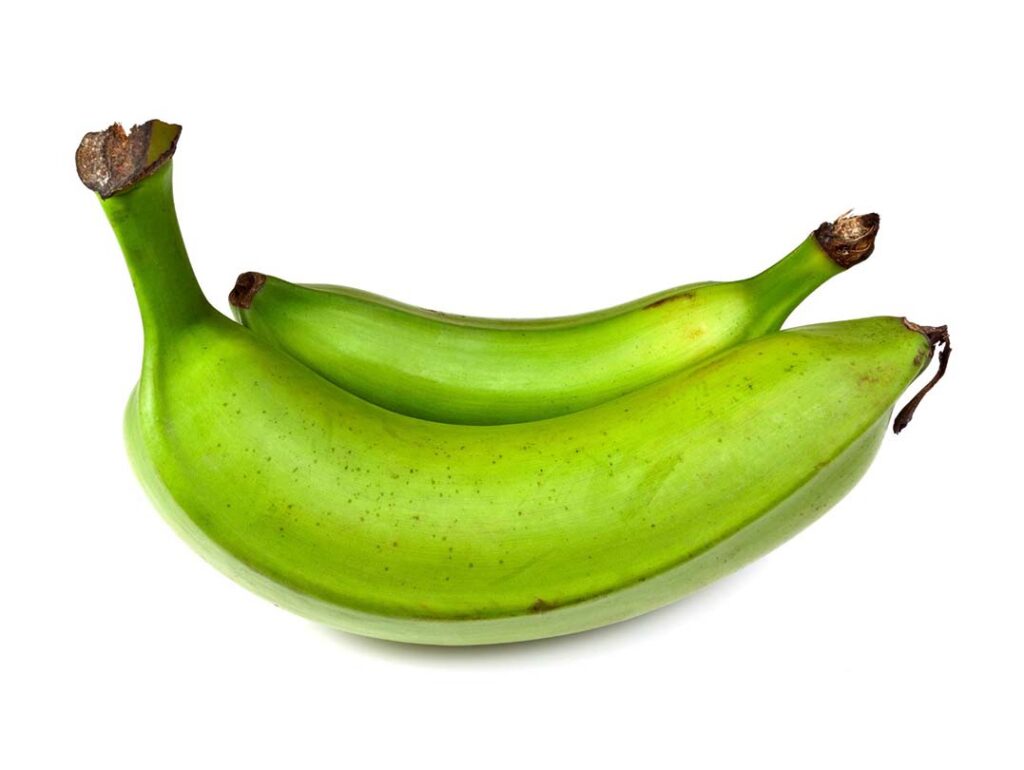
Yellow plantains:
Yellow or ripened plantains are less starchy and sweeter than the green ones. They are best cooked, boiled, baked, and fried.

Black plantains:
Do not get distracted by their color; they are the sweetest and softest plantains and are best baked and consumed as a dessert.

Nutrient Composition:
100 grams of plantains incorporate 122 kcal of energy and 1.3 grams of protein. They are a good source of carbohydrates providing 31.9 grams, divided into 1.7 grams of fiber and 17.5 grams of sugar. Plantains are low in fats incorporating only 0.35 grams in 100 g.
Among the micronutrients, they are packed with calcium, magnesium, potassium, phosphorus, vitamin C, A, and vitamin B6.
| Nutrients (100 g) | Amount |
|---|---|
| Proximate composition | |
| Water | 65.2 g |
| Energy | 122 kcal |
| Protein | 1.3 g |
| Total fats | 0.35 g |
| Carbohydrates | 31.9 g |
| Dietary fiber | 1.7 g |
| Total sugars | 17.5 g |
| Minerals | |
| Calcium | 3 mg |
| Iron | 0.55 mg |
| Magnesium | 36 mg |
| Phosphorus | 32 mg |
| Potassium | 487 mg |
| Sodium | 4 mg |
| Zinc | 0.19 mg |
| Copper | 0.074 mg |
| Manganese | 0.144 mg |
| Selenium | 1.5 µg |
| Vitamins | |
| Vitamin C | 18.4 mg |
| Thiamine (B1) | 0.062 mg |
| Riboflavin (B2) | 0.076 mg |
| Niacin (B3) | 0.672 mg |
| Panthotenic acid | 0.3 mg |
| Vitamin B6 | 0.242 mg |
| Folate | 22 µg |
| Choline | 13.5 mg |
| Vitamin A | 1130 IU |
| Vitamin K | 28.8 µg |
Role in Human Nutrition:
Adding plantains into our everyday diet may contribute to a wide variety of health benefits as they are rich in fiber, vitamins, and minerals:
Boosts digestive health:
The digestive system is responsible for breaking down the macro and micronutrients into simple nutrients so the body uses them for energy. The human gut is the largest system that digests and absorbs nutrients from food and excretes waste. Any disturbances in the digestive system can impair the body’s functions due to the malabsorption of nutrients.
The high starch and fiber content of plantains helps boost the digestive system. Starch is the major component of green plantains, while it is also fairly high in ripened ones. The highly resistant starch does not increase the caloric value of the food but provides physiological benefits such as improved bowel movement as a result of the production of short-chain fatty acids, colonic pH reduction, improved fecal output, enhanced gut bacteria activity, and reduced secondary bile acid excretion.
Furthermore, the considerable amount of soluble dietary fiber helps improve digestion by providing bulk in the food and stool and slowing down digestion for efficient nutrient absorption. A study worked on the effect of pectin, a soluble dietary fiber on the stool volume in hospitalized children with diarrhea. They concluded that consuming green plantain in the dietary management of diarrhea can improve stool volume and frequency in children (1).
Safeguards heart:
According to WHO, cardiovascular diseases are the leading causes of mortality worldwide with approximately 17.9 million precious lives wasted per year. Plantains are home to tons of heart-healthy nutrients such as potassium, magnesium, dietary fiber, and vitamin B6.
Potassium is essential for the normal functioning of the heart, nerves, and muscles. Consuming a potassium and magnesium-rich diet helps reduce blood pressure and lowers the risk of stroke; a serious risk factor for cardiovascular diseases. Usually, we opt for bananas to boost our potassium intake, but plantains have more of this blood pressure-lowering mineral than bananas. Plantains also regulate the sodium-potassium balance in the body, as excess sodium consumption leads to high blood pressure.
The vitamin B6 in plantains helps metabolize the macronutrients and is essential for healthy red blood cells and neurotransmitters. The B6 helps lower cardiovascular disease risk by reducing homocysteine levels, a type of amino acid that the body naturally produces. Its high levels damage the walls of arteries and increase the likelihood of developing cardiovascular complications. The soluble fiber in plantains reduces the risk of heart disease and stroke by lowering blood cholesterol levels.
Elevates the immune system:
Plantains are good sources of vitamins A and C and incorporating them into our diet can boost our immune system. These vitamins act as antioxidants by neutralizing free radicals and reducing oxidative stress. Antioxidants are substances that fight off free radicals in the body by donating an electron to stabilize them.
As antioxidants, these vitamins may protect your body from developing conditions related to free radical damage such as aging, heart diseases, and some types of cancers.
However, plantains are usually cooked before eating, and heat and light destroy Vitamin C. So a small tip to reserve vitamin C levels is to cook plantains for a short time and use a little boiling water.
Controls diabetes:
Diabetes mellitus is a metabolic disorder characterized by hyperglycemia and insulin resistance. Current strategies available for managing diabetes are exercise, diet, insulin therapy, and oral drugs. However, drug therapy is quite expensive and poses side effects which have led to an increased interest in managing this chronic condition with diet and exercise.
There’s quite a buzz around the intake of foods with low blood glucose potential, and plantain is one of them. Unripe plantain has major anti-hyperglycemic properties and reduces blood glucose levels. Foods with a glycemic index under 55 are considered good choices for diabetes and plantain has the GI in the 40s.
Moreover, the presence of abundant amounts of magnesium, iron, calcium, and potassium makes it beneficial for diabetes patients. This is confirmed by a study done in rats where they were provided unripe plantain which showed a significant reduction in blood glucose levels (2).
Boosts brain health:
Plantains are rich in vitamin B6 which energizes the neurotransmitters to carry information from cell to cell. B6 also helps increase the production of serotonin and dopamine, which help improve the mood and regulate the sleep cycle.
Helps manage weight:
The complex carbohydrates found in the humble plantain can help shed unwanted pounds. Plantains are an excellent option for weight loss owing to their high fiber and resistant starch content, and low glycemic index.
Fibers keep you full by remaining undigested in the stomach and move to the gut and ferment to feed the good bacteria residing in the gut, thereby not adding extra calories to your food. Resistant starches are the type of carbohydrates that resist digestion in the small intestine and act as prebiotics when they move to the large intestine. Their low glycemic index shows they do not cause a sudden spike in the blood glucose and keep it stable which may help keep the weight in control.
Aside from that, plantains are low in calories and fats, rendering them a good option in a weight loss diet. Pairing plantains with low-calorie and nutrient-dense foods such as vegetables, fruits, lean protein, and healthy fats can help you achieve your desired weight.
Keeps bones strong:
The high content of potassium, calcium, vitamin C, and magnesium in plantains is necessary for bone strength. Potassium prevents the wear and tear of the bones to keep them intact and strong while, magnesium boosts the uptake of calcium. We are highly aware of the role of calcium in bones; they form and maintain strong bones, teeth, and nails.
Vitamin C helps in the formation of collagen, a protein essential for the strengthening of bones. It also reduces the risk of osteoporosis, a condition characterized by weak and porous bones, particularly in post-menopausal women.
Treats anemia:
Anemia is a condition in which the body does not have enough healthy red blood cells. Plantains are good sources of B6 and folate that help produce red blood cells and treat anemia.
Side Effects:
Some of the negative symptoms experienced after consuming plantains are:
Allergy:
Allergy to plantain although not frequent can occur in some individuals. Consult your doctor immediately if you experience symptoms like itching, hives, or difficulty breathing after consuming the fruit.
Digestive issue:
The high resistant starch fiber content of plantains may not be suitable for people who are not used to consuming high content of these nutrients. Such people may experience gas, bloating, and constipation after eating plantains so they may want to start incorporating this food into small amounts in their diet.
How to incorporate plantains into the diet:
Plantains can be easily added to our diet in the following simple ways:
- Peel and slice the plantain and cut it into chunks. Boil for 15-20 minutes until soft. Serve as a side dish with your main meal.
- Another less healthy way to add plantains to your diet is frying. Fry them in boiling oil until golden brown and serve as a mid-day snack.
- Bake the plantains in the oven for 20-25 minutes at 375°F and serve.
- Add them to soups and stews.
- Replace the plantains with bananas in making banana bread.
- Steam and serve breakfast.
- Add baked plantain as a topping in breakfast oats.
- Add ripe plantains to your smoothies for sweetness as a replacement for table sugars.
Despite plantains being a healthy and nutritious food, some methods of cooking may make them unsuitable to add to our diet. One of them is frying which requires oil and increases the calorie and fats of the fruits.
The other is adding fruit to desserts with tons of added sugar, oil, and cream which makes it unhealthy. So, in terms of health, choose plantain foods that have fewer amounts of added sugar, oil, and salt for increased health benefits, promoting overall well-being.
Where to find them?
Plantains are the staple food in many regions so they may easily be available in supermarkets all year long and are super cheap like bananas. Tropical countries like Central and South America, the Caribbean, Africa, and Southeast Asia grow them so the crop is easily available throughout the year.
Plantain vs. Banana: Which is healthier?
Plantains and bananas belong to the same family however; differ in their taste, flavor, and culinary practices.
Plantains are thick, starchy, and less sugary than bananas whereas ripe bananas are smaller and sweeter than large plantains. In terms of nutrition, none is superior to the other and both need to be incorporated into our healthy diet. Both are rich sources of macro and micronutrients, including fiber, protein, potassium, fiber, magnesium, and antioxidants.
The major difference between the two is that carbohydrates in plantains come mainly from starch, while banana carbohydrates are mostly sugars.
Storage:
Plantains can be stored at room temperature away from sunlight for 7 to 10 days to allow them to ripen. The ripened ones can be put in the refrigerator to increase their shelf life. Avoid storing your plantains in plastic bags as they may seal the moisture and rot earlier than usual. For extended storage time, peel and slice the plantains and keep them in a freezer bag or an airtight container.
Plantains are tropical fruits enjoyed in many culinary cuisines around the world especially in Africa. They are not only delicious but are packed with nutrients that provide a plethora of health benefits. In addition to boosting you with energy, they are beneficial for a healthy immune system, and digestive health, prevent diseases and help manage weight. After delving into the nutritious world of plantains we witnessed the transformation of “the ordinary to the extraordinary”.




